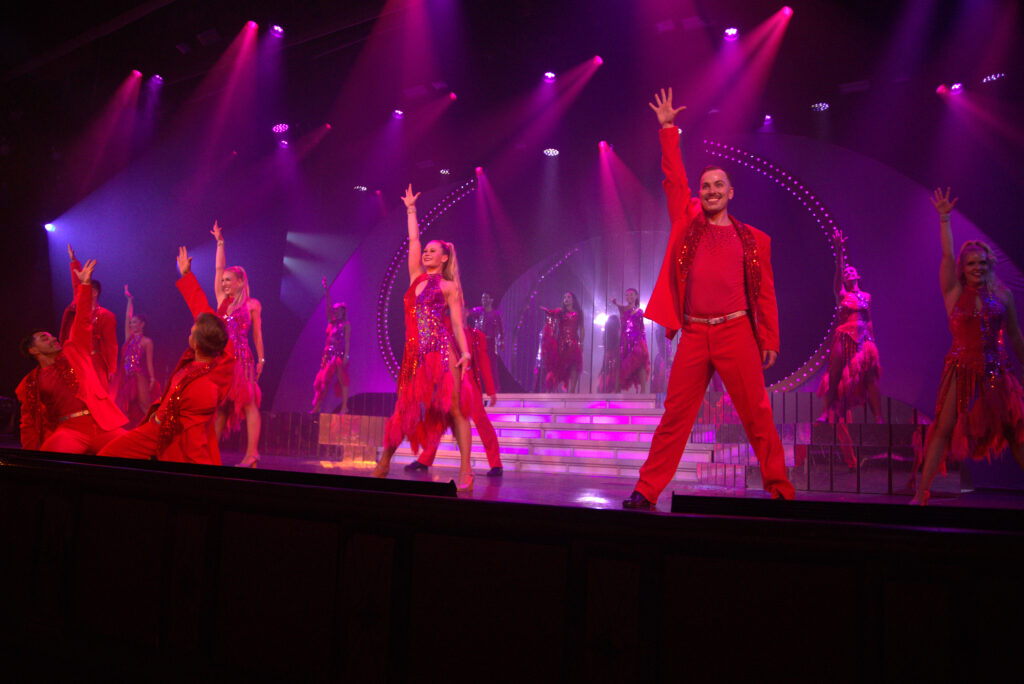Imagine traveling to beautiful destinations, making lifelong friends from all over the world, and performing high-energy shows for packed audiences. Working on a ship, it’s all part of a regular day in the office. As a production dancer onboard a major cruise line, my primary job is to perform in several shows and guest experiences during each voyage. But as a crew member, daily life onboard is filled with so much more than dancing, and it’s guaranteed to surprise you, challenge you, and help you grow both as a performer and a person.
My contract started with six weeks of rehearsals at the company’s studios. As soon as our cast of 10 dancers and four singers arrived, we jumped right into learning four production shows, as well as three pop-up performances, including our Sail Away Celebration and 80’s Dance Party.

Courtesy Sherwin
Like on most cruise ships, the shows required a lot of partnering, which I previously had not had much experience in. As our cast learned more about how to work with each other, however, I became more comfortable with trusting my partners and communicating how we could best execute difficult lifts and sequences together. Rehearsing seven hours a day for five days a week was at times a mental and physical challenge, but it built the stamina required for both demanding shows and the fast pace of life at sea.
Embarking on the ship in Fort Lauderdale, FL, I faced a whirlwind of new experiences. From figuring out how to fit my whole life into a tiny cabin with two bunk beds and one roommate to learning my emergency responsibilities as a crew member, it took time to adjust onboard, which is the case whether it’s your first contract or your fifth. Things I normally wouldn’t have thought twice about on land, such as how to dispose of my trash or make phone calls, all became a bit more complicated, not to mention constantly getting lost on the 18-deck ship until I learned my way around. But with the support of my cast, which basically acted as my family onboard, navigating my new home eventually became second nature.
Onboard, a second mini-rehearsal process, commonly called “install,” kicked off with a flurry of fitting costumes, blocking formations, and learning how to work with the props and set pieces onstage. It was thrilling to discover new performance elements I hadn’t encountered before, like a pit that rose up in the middle of the stage, and a live band that played alongside us. Other parts of install were more intimidating, like figuring out the best way to nail rapid-fire quick changes in the wings (our fastest was less than 25 seconds), and the unexpected challenge of dancing on a rocking ship (hello, core stability!)
Once all of the shows premiered, I settled into what was to be my new normal for the next several months at sea. On show days, our schedule resembled a contract on land. We’d start with listening to notes on our last performance from our cast manager, followed by some time onstage to make any necessary corrections or changes on our feet. We then ran through the entire show, minus costumes and technical elements. Afterwards, it was all about preparation: fixing and pre-setting costumes, warming up, doing hair and makeup, and going over any difficult lifts with my partners. And, finally, the best part: stepping onstage ready to do my best and support my cast.
 Courtesy Sherwin
Courtesy Sherwin
Exploring the ports during the day and performing at night certainly kept me busy; in just one contract, I visited more than 10 countries, including Antarctica! But there was also a lot of downtime, especially during sea days (when the ship isn’t docked at a port). Often, the cast will help with various events, such as hosting themed parties for the crew, teaching dance and fitness classes, or, in the case of our itinerary, acting in the longstanding maritime tradition of the “Crossing the Equator” ceremony for guests. We worked hard, but we also had a lot of fun.
Spending months away from friends and family can be isolating, and it’s hard to miss special moments like weddings and holidays back home. But I never feel truly alone on a ship; my fellow castmates, musicians, chefs, technicians, baristas, room stewards, and more become the familiar neighbors that I interact with on a daily basis, and those little interactions all add up to a broad sense of community onboard that I know I can fall back on.
 Courtesy Sherwin
Courtesy Sherwin
As a performer at sea, the only constant is change. Ports change, crew members outside of the cast are constantly joining and leaving, and you never know when you’ll face the unexpected, like having to re-block a show at the last minute for a sick castmate. But if you stay flexible and embrace every new challenge as an opportunity to learn, there’s no limit to what you can discover. I certainly believe I have one of the best jobs a dancer could ask for, and I’m excited to see where the high seas take me next.





GIPHY App Key not set. Please check settings